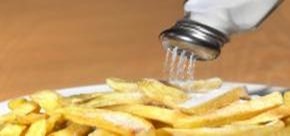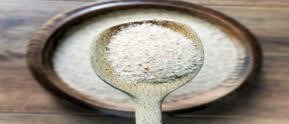Role of salt in human health
Sheeba Sherin Charles*
Dietitian, Kauvery Hospital, Heartcity, Trichy, India.
Background
Sodium chloride, commonly known as table salt, is an ionic compound with the chemical formula NaCl, representing a 1:1 ratio of sodium and chloride ions. Sodium chloride is one of the largest volume inorganic raw materials. Some of the earliest evidence of salt processing dates to around 6000 BC, when people living in the area of present-day Romania boiled spring water to extract salts.

Health effects of Salt
Cutting back on salt can reduce blood pressure, but often, the change in blood pressure is small. According to the American Heart Association, a person who reduces salt intake from median levels (around 3,400 milligrams (mg)) to the federal recommended levels (no more than 2,300 mg) typically sees a slight drop of 1–2% in blood pressure, on average. Eating foods high in potassium also seems to counter some of the effects of high salt consumption on blood pressure.
Salt directly affects other nutrients. For instance, consuming a lot of salt may cause more calcium to be excreted in the urine. Calcium is a mineral that helps to strengthen bones, so people on a high-salt diet may need more calcium to make up for the calcium lost (along with the excess sodium). In addition, urinary calcium, the main constituent of kidney stones, which increased by a high salt diet. Therefore, a high-salt diet can lead to painful kidney stones.
How much is enough?
Current dietary guidelines recommend no more than 2,300 mg of sodium, about a teaspoon of salt per day, for teens and adults. For children aged 2–15 years, WHO recommends adjusting the adult dose downward, based on their energy requirements. No more than 1,500 mg per day is recommended for groups at higher risk of heart disease.
Symptoms of salt deficiency
These symptoms can include:
- Nausea and/or vomiting.
- Muscle weakness, spasms (twitching), or cramps.
- Low blood pressure.
- Dizziness when standing up.
- Low energy or fatigue.
- Loss of appetite.
- Restlessness or bad temper.
More serious symptoms can happen in severe cases when the level of sodium in blood is extremely low. These include;
- Altered mental status (severe confusion)
- Hallucinations
- Decreased consciousness
- Seizures
- Coma
Toxicity
Too much sodium in the blood is called as hypernatremia. This acute condition can happen in older adults who are mentally and physically impaired who do not eat or drink enough, or who are sick with a high fever, vomiting, or infection that causes severe dehydration. Excessive sweating or diuretic medications that deplete the body of water are other causes. When sodium accumulates in the blood, water is transferred out of cells and into the blood to dilute it. This fluid shift and a build-up of fluid in the brain can cause seizures, coma, or even death. Extra fluid collecting in the lungs can cause difficulty breathing. Other symptoms of hypernatremia can include; nausea, vomiting, weakness, loss of appetite, intense thirst, confusion, kidney damage.
Six roles of salt in food
Salt is more than a flavoring agent that can be used in many different ways. Here are the six most important things salt does for food
1. Flavor Enhancer

Salt is the most common seasoning in the world and it is used to enhance food flavor. Salt can bring out ingredients’ natural flavors and make food taste better.
2. Preservative

Salt has been used as a preservative for a very long time. Salt can stop bacteria and mold from growing in food, which can make it, last longer.
3. Color Enhancer

Salt can give food a new color by making it more appealing. For example; salt can help bread crusts get a golden color and make pasta dishes look more colorful.
4. Texture Improver

Salt can help make food feel better. Adding salt to bread dough strengthens the gluten and provides a uniform texture.
5. Nutrient Source
Salt is a provider of sodium which a nutrient, for maintaining good health. Sodium is an electrolyte that plays a role, in regulating balance, nerve functioning, and muscle contractions.
6. Binder

Salt can serve as a binder when used in processed meat. By adding salt the proteins, in the meat form a gel substance that aids in keeping the meat intact and prevents it from cracking during the cooking process.
Different types of salt
- Kosher salt
- Table salt
- Fleur de sel
- Sea salt
- Celtic sea salt
- Flake salt
- Pink salt
- Black salt
- Red salt
- Black lava salt
- Flavored salts
Advantages of Salt
1. Helps you stay hydrated:
To stay better hydrated your body needs a delicate balance of sodium and potassium. This is because water in your body follows sodium, so if you have too much your body will retain water. Potassium works to balance this out, which is why sea salt is much better than sodium chloride or table salt. Sea salt like Celtic or pink Himalayan contains both sodium and potassium, which helps balance your levels naturally.
2. Balances electrolytes and prevents muscle cramping:
Sea salt is an excellent source of electrolytes, which has been shown to prevent muscle cramping during exercise. Sea salt contains sodium, magnesium, potassium, and calcium, all of which you need for optimal health. These minerals must come from your diet because your body can’t create them. Without sufficient electrolytes you can experience irregular heartbeat, fatigue, nausea, and even seizures.
3. Supports a healthy nervous system:
Sodium regulates water flow throughout your body, which is critical for a healthy nervous system. Additionally, the water of your nervous system requires salt for electrical conduction to send and receive nervous system signals. Just as with other functions of the body, your brain needs the right balance of sodium to other electrolytes, which is why sea salt is a much better option than table salt.
4. Improves sleep
When you read about salt and sleep, it initially appears there are mixed reports. But if you pay close attention, you’ll realize that the advice against eating salt before bed is referring to table salt and processed foods, which can cause an unbalanced amount of sodium in the body. Sea salt is thought to improve sleep because it contains so many helpful electrolytes for regulating hormones.
5. Good for dental hygiene:
Most of the dentists also suggest that we should rinse our mouth using the saltwater, as it helps keep the mouth bacteria away. A mixture of baking soda, salt, and warm water, is also being used for whitening the teeth and keeping the plaque away. This also helps in reducing the swelling in the gums and keep them healthy.
When you swap your table salt for a natural salt you might find you have better sleep, are less thirsty, hungry, and more satisfied when you eat. It’s also important to make sure you get enough salt anytime you exercise because your body is sweating it out. For anyone who participates in high intensity sports or competition, they make salt tablets for better rehydration.
Disadvantages of Salt
1) Damages kidneys
One of the adverse effects of consuming salt is on kidneys only. As salt has sodium present in it, and it affects the kidneys. The minerals present in salt lead to a rise in blood pressure. This results in the formation of crystals in the kidneys, which can cause damage to them.
2) Hypertension
Another adverse effect of salt on our body is hypertension. This is also because consuming an excess of salt will raise the blood level and blood pressure. This leads to cardiovascular risks like heat stroke. So, try to consume salt in a limited quantity only.
3) Obesity
You all would have heard that consumption of excess salt could even lead to weight gain also. That is why the people who are trying to lose weight are recommended to keep less salty food items in their diet.
Summary and Conclusion
Salt is a mineral containing sodium that is essential body processes. However, if a person’s salt intake is too high, they may be at risk of developing certain health conditions. Salt is present in many foods, so a person should be careful to choose foods low in salt and sodium. Reducing salt intake can help to improve a person’s heart health. The amount of salt a person needs depends on their age and overall health.

